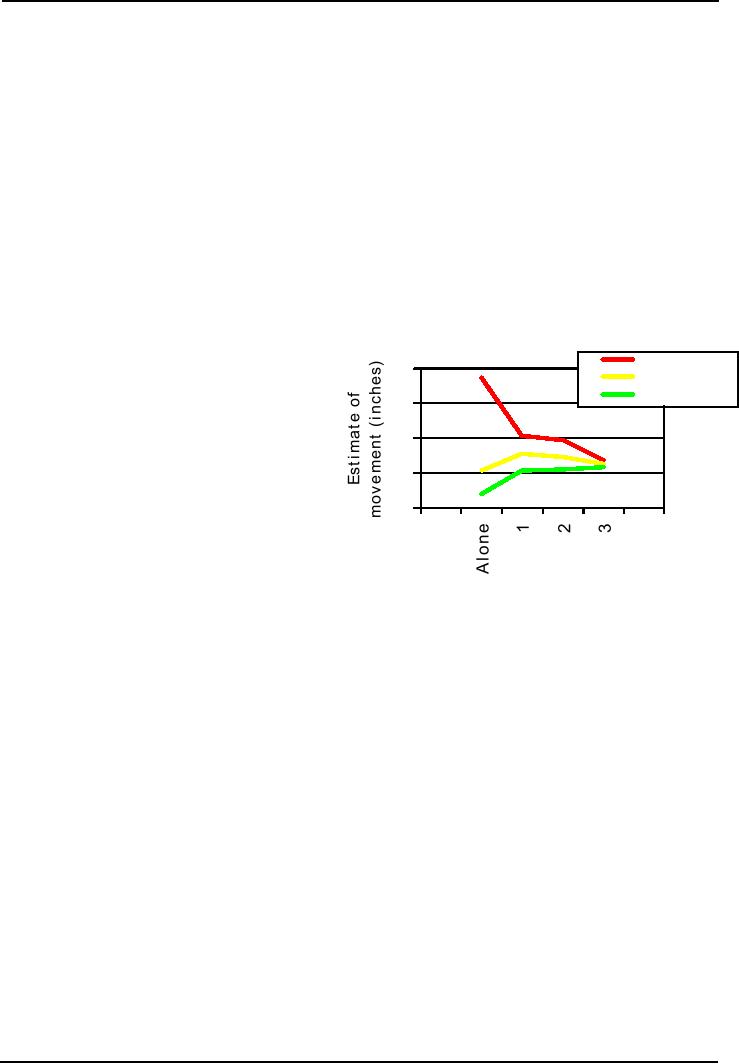 |

Social
Psychology (PSY403)
VU
Lesson
31
SOCIAL
INFLUENCE
A
few topics relevant to previous chapter
will be described first, and
then Social Influence will
be
discussed.
Childhood
attachment styles and adult
romantic relationships
·
Until
the mid 1980, all research
on attachment styles focused on children and
adolescents' social
relationships.
The secure and insecure attachment styles
were researched by Ainsworth and
other
developmental
psychologists.
·
Hazan
and Shaver, both social psychologists, were
Interested in whether attachment styles
might
affect
adult romantic
relationships
·
In
1987, Cindy Hazan and Philip Shaver
developed self-report measures of
attachment styles
·
They
inserted their attachment measures into a
"love quiz", and asked
newspaper readers
about
their
current romantic
relationships.
·
Securely
attached adults reported more positive
relationships with their
parents than those
with
insecure
attachment styles.
·
Cultural
differences:
Individualistic cultures placed great importance on
love in marriage
compared
to collectivistic countries like India,
Pakistan, Thailand, and Philippines
(Levine et al.,
1995)
·
Passion
is the hot
point of love
indicating
intense feeling, arousal,
physical
attraction, satisfying
other
drives
and needs
Sternberg's
Triangular Theory of Love
·
Intimacy
is the warm
point of love
INTIMACY
characterized
by close,
connected,
bonded
feelings, helping, being
happy
Liking
Companionate
Romantic
with,
respecting,
mutually
Love
Love
understanding,
sharing, and supporting
Consummate
Love
behavior.
Infatuation
Empty
Love
Fatuous
Love
·
Commitment
is the cool
point of love. It
PASSION
COMMITMENT
is
deliberate choice about
loving
someone,
maintaining long term commitment
and short time decisions about
being in love.
·
Companionate
love is
characterized by self disclosure, closeness,
and concern after living
long
with
each other. When our
lives are intertwined with
someone, feelings such as
affection,
tenderness,
sharing, and attachment become a hallmark
of relationship.
Attachment
styles & Friendship
As
children grow up, they
form emotional ties not only
with family but they
also form friendships
with
their
peers. Friendship is different
from family relations, which
are largely nonvoluntary. As
compared
to
those, relationships based on
friendships are
voluntary.
Two
different levels of
friendship
·
Superficial
friendships are
formed and maintained
because they are rewarding,
and are based on
the
principle of exchange
125

Social
Psychology (PSY403)
VU
·
Developed
friendships in contrast
are based not only on
rewards but also on friends'
mutual
concern
for each other's
welfare
·
Disclosure
is the
revealing of personal information about
oneself to other people. One
of the prime
avenues
for creating developed
friendships is through self-disclosure. People
not availing this
type
of
communication will have dysfunctional
relationships and loneliness (Stokes,
1987)
Social
penetration theory (Altman and
Taylor, 1973)
·
The
development of a relationship is
associated with communication
moving gradually from
a
discussion
of superficial topics to more intimate
exchanges
·
Cultural
differences: North
Americans tend to disclose more
about themselves in a wider
variety
of
social settings than people from
collectivistic cultures (Chen,
1995)
·
Gender
differences: In a meta
analysis of 205 studies, Kathryn
Dindia and Mike Allen
(1992)
found
that women self-disclose more than
men
PART
III: EVALUATING PERSONS AND
RELATIONSHIPS
Close
Relationships was the last chapter of
section III, i.e., "Evaluating persons
and relationships".
That
section comprised on five following
chapters: Attitudes, Attitude
change, Prejudice and
Discrimination,
Interpersonal Attraction, and Close
Relationships. Apparently, these
all topics seem
different;
however they all are
about the evaluation of other
people.
PART
IV: SOCIAL INTERACTIONS
The
fourth section of syllabus on Social
Psychology is concerned with
different forms of social
interactions
that people would have with
each other. This section
consists on five chapters
namely,
Social
Influence, Aggression, Prosocial
Behavior, Group Behavior, and
Interpersonal Power. In
the
following,
a brief description about
each chapter is provided:
·
Social
influence is concerned with
how one person's behavior influences
another person's
behavior.
·
Aggression
is the negative side of social
interaction. Psychologists want to know
how to overcome
aggression.
They are also interested in
knowing that why people
assault, rape, and kill each
other.
·
Prosocial
Behavior: Social psychologists are
interested to know that what
makes people help
each
other
and what goes wrong when
people fail to help victims
in emergency situations
·
Group
interaction: Psychologists are also
interested to know that how
individuals behave
differently
when they are in groups, and
also that whether groups
perform better or worse
than
individuals.
·
Interpersonal.
Power: is the dark side of
social interaction. Social psychologists
desire to know that
why
ordinary human beings sometime follow
immoral orders to engage in
torture, ethnic cleansing,
and
genocide.
SOCIAL
INFLUENCE
Chapter
Summary
This
chapter introduces conformity, compliance,
and obedience as forms of social
influence.
Conformity
is described as changing one's behavior
to be consistent with group
standards. The chapter
reviews
the classic studies of Sherif
and Asch. The meaning and
incidence of conformity is
contrasted
across
individualistic and collectivistic cultures.
Informational influence and normative
influence are
discussed
as the two major motivators
of conformity. The conditions
under which people are
likely to
conform
or resist conforming (commitment to a
group, cohesiveness, group
size, unanimity, and
minority
influence) are presented.
The application of social psychological
knowledge on conformity to
126

Social
Psychology (PSY403)
VU
health
campaigns is highlighted. Compliance is
defined as responding to a request
from another
individual
or group. Research on the role of
mood and compliance is presented.
More specific
compliance
techniques, such as foot-in-the-door,
door-in-the-face, low-ball,
"that's-not-all," and the
pique
technique are compared. Obedience is
defined as complying with the
request of a legitimate
authority.
The Eichmann
defense is given as
an example of extreme deference to
authority and sets
the
stage
for a discussion of the effects and
crimes of obedience. Milgram's experiments
are presented, and
the
factors that enhance or reduce obedience
are discussed. Finally, the
ethical considerations
surrounding
obedience research are
noted.
Introduction
·
Social
influence can be practiced by religious
and political leaders, etc.
This chapter will
discuss
the
social psychology of influence in
its various forms.
·
Social
influence is `the exercise of
social power by a person or
group to change the attitudes
or
behavior
of others in a particular
direction'.
·
Examples:
After the following two
events, pressure and
influence of entire Muslim
community
forced
those, who were responsible for
these events, to
apologize.
o
Cartoons of Prophet
Mohammad (PBUH) in Denmark,
November 2005
o
Pope
Benedict XVI's remarks for Prophet
Mohammad in 2006;
Behavioral
consequences of social
influence
Conformity
is
`a yielding to perceived group
pressure by copying the behavior and
beliefs of others'.
It
indicates to what degree you
conform to others' social influence in
dress, food and music
preferences,
etc. We can be influenced by
our family, friends,
teachers, and authority
figures.
Independence
is a state different from
conformity and it indicates that you
are not controlled by
others.
However,
when you do not conform,
may be you are acting
independently or conforming to
another
group.
Compliance:
Publicly acting in accord
with a direct request, e.g.,
standing and singing national
anthem
in
public ceremonies. Although
privately we agree or disagree
with the behavior we are
engaging in,
we
nevertheless indulge in that
behavior to comply.
Obedience
is
`the performance of an action in response
to a direct order". Obedience is taught
from
childhood
to respect and obey authority
figures (e.g., by parents, police,
and teachers), more so in
traditional
Asian cultures. Actually, compliance
implies loss of personal freedom
which is valued very
much
in individualistic cultures. People usually
prefer to comply with a
request rather than
being
ordered.
Classic
& contemporary conformity
research
·
Norm
development (Muzafir Sherif,
1935)
·
Solomon
Asch's work on group
pressure
·
Stanley
Schachter's work on how
people react to
nonconformists
Norm
development (Muzafir Sherif,
1935)
Sherif
was Turkish-born. His
research was partly spurred by his
disagreement with individualistic
cultures
which maintain that a group
is merely a collection of individuals and
no new group
qualities
arise
when individuals form into a
collective entity. He contended that a
group was more than sum
of
its
individuals' nongroup thinking. He
studied how social norms
develop into a group. In the
following,
his
experiments are illustrated:
Phase
1:
·
`Visual
perception experiment'
·
How
far does the dot
move?
127

Social
Psychology (PSY403)
VU
·
100
judgments - but movement was an optical
illusion - the `autokinetic
effect'
·
Participants'
judgments regressed towards a consistent range of
light movement (although the
actual
magnitude of estimated movement varied
across participants)
Phase
2:
·
Public
announcement of estimates; "not
free-for-all bickering of light movement
experts"
·
This
lead to a convergence of all
participants' responses away
from initially disparate estimates to
a
common
standard
·
This
common group standard is known as a
"social
norm"
·
Participants
denied that other's judgments
affected their own
·
Uncertainty
increased the rate at which convergence on the social
norm develops
·
In
uncertain situations other's judgments
are a valuable heuristic (or
rule of thumb) that can
help us
be
as accurate as possible
The
following graph illustrates
these
results
more clearly:
Norm
Development (Sherif, 1935)
Participant
1
8
Participant
2
Reading
Participant
3
·
Franzoi,
S. (2003). Social
Psychology.
6
Boston:
McGraw-Hill. Chapter 9.
4
Other
Readings
2
·
Lord,
C.G. (1997). Social
Psychology.
Orlando:
Harcourt
Brace
and
0
Company.
Chapter 8.
·
David
G. Myers, D. G. (2002). Social
Psychology
(7th
ed.). New York:
McGraw-Hill.
Successive
trials with other group
members
128
Table of Contents:
- INTRODUCTION TO SOCIAL PSYCHOLOGY:Readings, Main Elements of Definitions
- INTRODUCTION TO SOCIAL PSYCHOLOGY:Social Psychology and Sociology
- CONDUCTING RESEARCH IN SOCIAL PSYCHOLOGY:Scientific Method
- CONDUCTING RESEARCH IN SOCIAL PSYCHOLOGY:Evaluate Ethics
- CONDUCTING RESEARCH IN SOCIAL PSYCHOLOGY RESEARCH PROCESS, DESIGNS AND METHODS (CONTINUED)
- CONDUCTING RESEARCH IN SOCIAL PSYCHOLOGY OBSERVATIONAL METHOD
- CONDUCTING RESEARCH IN SOCIAL PSYCHOLOGY CORRELATIONAL METHOD:
- CONDUCTING RESEARCH IN SOCIAL PSYCHOLOGY EXPERIMENTAL METHOD
- THE SELF:Meta Analysis, THE INTERNET, BRAIN-IMAGING TECHNIQUES
- THE SELF (CONTINUED):Development of Self awareness, SELF REGULATION
- THE SELF (CONTINUE…….):Journal Activity, POSSIBLE HISTORICAL EFFECTS
- THE SELF (CONTINUE……….):SELF-SCHEMAS, SELF-COMPLEXITY
- PERSON PERCEPTION:Impression Formation, Facial Expressions
- PERSON PERCEPTION (CONTINUE…..):GENDER SOCIALIZATION, Integrating Impressions
- PERSON PERCEPTION: WHEN PERSON PERCEPTION IS MOST CHALLENGING
- ATTRIBUTION:The locus of causality, Stability & Controllability
- ATTRIBUTION ERRORS:Biases in Attribution, Cultural differences
- SOCIAL COGNITION:We are categorizing creatures, Developing Schemas
- SOCIAL COGNITION (CONTINUE…….):Counterfactual Thinking, Confirmation bias
- ATTITUDES:Affective component, Behavioral component, Cognitive component
- ATTITUDE FORMATION:Classical conditioning, Subliminal conditioning
- ATTITUDE AND BEHAVIOR:Theory of planned behavior, Attitude strength
- ATTITUDE CHANGE:Factors affecting dissonance, Likeability
- ATTITUDE CHANGE (CONTINUE……….):Attitudinal Inoculation, Audience Variables
- PREJUDICE AND DISCRIMINATION:Activity on Cognitive Dissonance, Categorization
- PREJUDICE AND DISCRIMINATION (CONTINUE……….):Religion, Stereotype threat
- REDUCING PREJUDICE AND DISCRIMINATION:The contact hypothesis
- INTERPERSONAL ATTRACTION:Reasons for affiliation, Theory of Social exchange
- INTERPERSONAL ATTRACTION (CONTINUE……..):Physical attractiveness
- INTIMATE RELATIONSHIPS:Applied Social Psychology Lab
- SOCIAL INFLUENCE:Attachment styles & Friendship, SOCIAL INTERACTIONS
- SOCIAL INFLUENCE (CONTINE………):Normative influence, Informational influence
- SOCIAL INFLUENCE (CONTINUE……):Crimes of Obedience, Predictions
- AGGRESSION:Identifying Aggression, Instrumental aggression
- AGGRESSION (CONTINUE……):The Cognitive-Neo-associationist Model
- REDUCING AGGRESSION:Punishment, Incompatible response strategy
- PROSOCIAL BEHAVIOR:Types of Helping, Reciprocal helping, Norm of responsibility
- PROSOCIAL BEHAVIOR (CONTINUE………):Bystander Intervention, Diffusion of responsibility
- GROUP BEHAVIOR:Applied Social Psychology Lab, Basic Features of Groups
- GROUP BEHAVIOR (CONTINUE…………):Social Loafing, Deindividuation
- up Decision GROUP BEHAVIOR (CONTINUE……….):GroProcess, Group Polarization
- INTERPERSONAL POWER: LEADERSHIP, The Situational Perspective, Information power
- SOCIAL PSYCHOLOGY APPLIED: SOCIAL PSYCHOLOGY IN COURT
- SOCIAL PSYCHOLOGY APPLIED: SOCIAL PSYCHOLOGY IN CLINIC
- FINAL REVIEW:Social Psychology and related fields, History, Social cognition